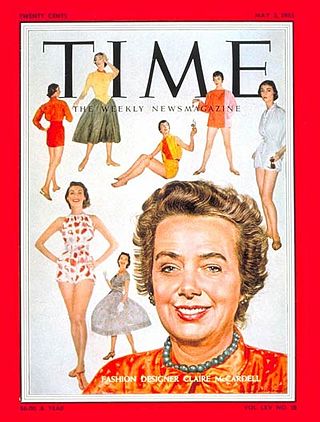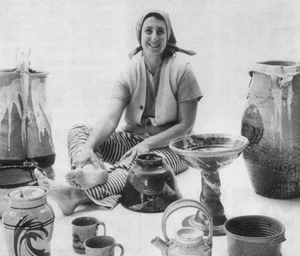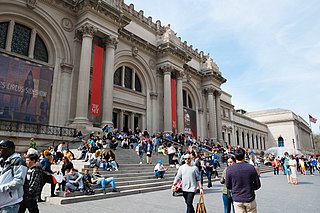
The Autophone was an early type of organette, invented in 1878 by Henry Bishop Horton. [1] One of the first table-top organettes to be mass-produced, it played music using punched cards to activate 22 reeds. [2]

The Autophone was an early type of organette, invented in 1878 by Henry Bishop Horton. [1] One of the first table-top organettes to be mass-produced, it played music using punched cards to activate 22 reeds. [2]
![]() The dictionary definition of Autophone at Wiktionary
The dictionary definition of Autophone at Wiktionary

The Metropolitan Museum of Art, colloquially referred to as the Met, is an encyclopedic art museum in New York City. By floor area, it is the fourth-largest museum in the world and the largest art museum in the Americas. With 5.36 million visitors in 2023, it is the most-visited museum in the United States and the fifth-most visited art museum in the world.

Charles-François Daubigny was a French painter, one of the members of the Barbizon school, and is considered an important precursor of impressionism.

Lucas van Leyden, also named either Lucas Hugensz or Lucas Jacobsz, was a Dutch painter and printmaker in engraving and woodcut. Lucas van Leyden was among the first Dutch exponents of genre painting and was a very accomplished engraver.

Claire McCardell was an American fashion designer of ready-to-wear clothing in the twentieth century. She is credited with the creation of American sportswear.

Elizabeth Woodman was an American ceramic artist.

Peter Reginato, is an American abstract sculptor and painter.

The Egyptologists Nina M. Davies and Norman de Garis Davies were a married couple of illustrators and copyists who worked in the early and mid-twentieth century drawing and recording paintings in Egypt. Their work was often published together, as N. de Garis Davies, and so it is usually difficult to determine who drew which illustration.

The Met Gala, formally called the Costume Institute Benefit, is the annual haute couture fundraising festival held for the benefit of the Metropolitan Museum of Art's Costume Institute in Manhattan. The Met Gala is popularly regarded as the world's most prestigious and glamorous fashion event. Fashion stars and models are able to express themselves by their fit according to the theme and social gathering. The event is known as "fashion's biggest night"; an invitation is highly sought after. Personalities who are perceived to be culturally relevant to contemporary society amongst various professional spheres, including fashion, film, television, music, theater, business, sports, social media and politics, are invited to attend the Met Gala, organized by the fashion magazine Vogue. The entry price for one ticket has risen to US$75,000 in 2024, an increase from $50,000 in 2023, to attend the annual gala in the world's principal financial center and fashion capital, New York City.

The Hurrian foundation pegs, also known as the Urkish lions, are twin copper foundation pegs each in the shape of a lion that probably came from the ancient city of Urkesh in Syria. The pegs were placed at the foundation of the temple of Nergal in the city of Urkesh as mentioned in the cuneiform inscriptions on them. The inscription on the two pegs and the associated stone tablet is the oldest known text in the Hurrian language. One of the lions is now housed, along with its limestone tablet, in the Musée du Louvre in Paris. The second lion is on display at the Metropolitan Museum of Art in New York.

"William", also known as "William the Hippo", is an Egyptian faience hippopotamus statuette from the Middle Kingdom, now in the collection of the Metropolitan Museum of Art in New York City, where it serves as an informal mascot of the museum. Found in a shaft associated with the Upper Egyptian tomb chapel of "The Steward, Senbi", in what is now Meir, William dates from c. 1961 BC – c. 1878 BC, during the reigns of Senusret I and Senusret II. This 20 cm figurine in Egyptian faience, a clay-less material, has become popular not only for his endearing appearance, but also because his defining characteristics illustrate many of the most salient facets of craft production in ancient Egypt during this time.
Mahrukh Tarapor is an Indian museum professional and art consultant, known for her scholarship in museum art, especially Islamic art. She was honoured by the Government of India, in 2013, by bestowing on her the Padma Shri, the fourth highest civilian award, for her contributions to the field of art.

The Met Breuer was a museum of modern and contemporary art at Madison Avenue and East 75th Street in the Upper East Side of Manhattan, New York City. It served as a branch museum of the Metropolitan Museum of Art from 2016 to 2020.

A Storm, a 1922 pastel painting by Georgia O'Keeffe, shows lightning over a lake and the reflection of the moon, while alluding to a feminine body shape. The medium is pastel on paper, mounted on illustration board.

Lucretia is a 1500s drawing by the Italian High Renaissance artist Raphael, now in the collection of the Metropolitan Museum of Art.

Woman Seen from the Back is an 1860s photograph by 19th-century French photographer, Vicomte Onesipe Aguado de las Marismas. It is in the collection of the Metropolitan Museum of Art, and was purchased by the Museum in 2005 as part of the Gilman Photographs Collection.

Mother and Child (The Oval Mirror) is an oil-on-canvas painting by the American Impressionist artist Mary Cassatt. The painting depicts a mother and her child in front of a mirror. The painting provides a glimpse of the domestic life of a mother and her child, evoking religious iconography from the Italian Renaissance. However, portrayals of a mother and her child are common in Cassatt's work, so it is possible that this similarity is coincidental rather than intentional.
Mabel Rose Welch was an American painter of portrait miniatures.
Irene Hilde Aronson was a German-born American painter and printmaker.

Before Yesterday We Could Fly: An Afrofuturist Period Room is an art exhibition at the Metropolitan Museum of Art in New York City. The exhibit, which opened on November 5, 2021, uses a period room format of installation to envision the past, present, and future home of someone who lived in Seneca Village, a largely African American settlement which was destroyed to make way for the construction of Central Park in the mid-1800s.